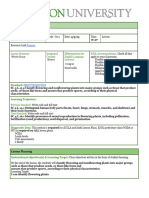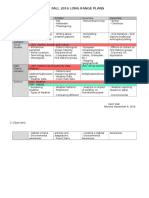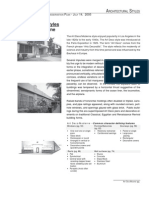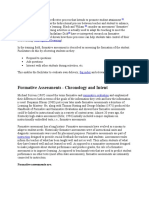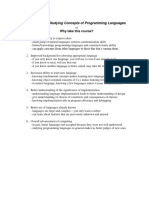Lesson Plan: Outcomes From Alberta Program of Studies
Lesson Plan: Outcomes From Alberta Program of Studies
Uploaded by
api-297105215Copyright:
Available Formats
Lesson Plan: Outcomes From Alberta Program of Studies
Lesson Plan: Outcomes From Alberta Program of Studies
Uploaded by
api-297105215Original Title
Copyright
Available Formats
Share this document
Did you find this document useful?
Is this content inappropriate?
Copyright:
Available Formats
Lesson Plan: Outcomes From Alberta Program of Studies
Lesson Plan: Outcomes From Alberta Program of Studies
Uploaded by
api-297105215Copyright:
Available Formats
LESSON PLAN TEMPLATE A
Grade/Subject: Grade 1/2 Science
Miss Wall
Lesson Plan
Unit: Needs of Plants and Animals
Lesson Duration: 60 Minutes
OUTCOMES FROM ALBERTA PROGRAM OF STUDIES
General Learning Outcomes:
1-11 Describe some common living things and identify needs of those living things
Specific Learning Outcomes:
1. Observe, describe, and compare living things
LEARNING OBJECTIVES
Students will:
1. Observe their plants tomatoes and bean/pea seeds.
2. Record their observations into their booklets
3. Make general comparisons to day 1 and now.
ASSESSMENTS
Observations:
- Observe students as they are doing their recording.
- Make sure students are spelling correctly and using punctuation properly.
- Observe student movement. Make sure students are on task and not chatting with
other students.
Written/Performance Assessments:
- Observation booklet
Key Questions:
- What changes have
occurred with our
plants?
MATERIALS AND EQUIPMENT
* Observation books
* Pencils/pencil crayons
PROCEDURE
Introduction (15 min.):
DO: Welcome Ms. Burleigh to the classroom and explain who she is to the students.
Assessment of Prior Knowledge: Last week we planted seeds. Hands up if you can tell me the three different types of
seeds we planted. (Bean, Pea, Tomato)
- We also drew our predictions into our observation booklets. Today we need to add to our booklets and record what
our plants look like now.
- When we are taking an observation, we use our eyes to see what is different with our plant. If we are just looking at
our plants, should be talking? Wait for students to shake their heads. After you have looked at your plant, you need to
write down a small sentence on what you observed and draw a picture of what your plant looks like now.
Expectations for Learning and Behaviour:
Remember that when we are looking at our plants, we need to be quiet so that other people can think and write down
what they see.
Advance Organizer/Agenda:
Transition to Body:
Body (35 min.):
Demonstrate:
1. First you will need BOTH of your observation books. Your big one will be to record your tomatoes and the little one
will be to record our greenhouse seeds on the wall.
2. We planted our seeds last Tuesday, how many days has it been since Tuesday? Wait for hands to go up. (answer is
day 7.)
3. We need to write down 7 beside Day in our books because it has been 7 days. We planted last Tuesday (day 1) and it
is now day 7 of growth.
4. After we write down Day 7, we need to write a sentence about our plant. How has it changed? Start with: Today, my
plant looked like _______.
Examples: Today my plant looked like it had grown! Today my plant looked like it did not grow. Today my plant
looked like it sprouted. OR Today, my plant had a small stem. It looks like it grew! My plant does not look like it has
grown.
- - for plants on the greenhouse wall, you can write: My plant has a big root growing out of it. Or my plant has many
roots growing! You can also write, my bean plant is growing, but my pea plant is not. Etc.
** We need to have correct spelling. Remember to check the word wall and sound out your words.
LESSON PLAN TEMPLATE A
Miss Wall
5. After you write down your sentence, you need to draw what your plant looks like. Make sure that you draw exactly
what you see. You want to be able to look back and see the different ways your plant has changed and grown. It would
be a great idea to color your picture!
6. Say after they have almost finished working: When you are done your observations, please put both your booklets
back into the science basket and find a quiet reading spot. You can read a classroom book or from your book bin. You
need to do silent reading because others are still trying to finish their work and need quiet to think.
Closure (5-10 min.):
Ask students to share some of their observations (if there is time). Ask students what they predict their plant might
look like in a few days. Ask if any students plants have not sprouted yet.
You might also like
- Lesson 3 Plant NeedsDocument3 pagesLesson 3 Plant Needsapi-550211632No ratings yet
- Germination LessonDocument4 pagesGermination Lessonapi-219914719No ratings yet
- ED 345 Calvin College Lesson Planning FormDocument3 pagesED 345 Calvin College Lesson Planning Formapi-240589503No ratings yet
- Why Should Scientists Keep Detailed Observations? (Lesson Plan ForDocument4 pagesWhy Should Scientists Keep Detailed Observations? (Lesson Plan Forapi-271760801No ratings yet
- Lesson 4 Plants We EatDocument3 pagesLesson 4 Plants We Eatapi-550211632No ratings yet
- Thematic Unit 1Document16 pagesThematic Unit 1api-317361617No ratings yet
- Science Lesson E-UnitDocument5 pagesScience Lesson E-Unitapi-351562010No ratings yet
- Lesson Plan Science PortfolioDocument4 pagesLesson Plan Science Portfolioapi-273332088No ratings yet
- One SeedDocument3 pagesOne Seedapi-219914719No ratings yet
- Science Lesson PlanDocument9 pagesScience Lesson Planapi-4573500530% (1)
- Science Lesson 1 1Document12 pagesScience Lesson 1 1api-456889650No ratings yet
- Freckle Juice - Lesson 1 - Making PredictionsDocument5 pagesFreckle Juice - Lesson 1 - Making Predictionsapi-240053435No ratings yet
- Lesson 4Document5 pagesLesson 4api-432033189No ratings yet
- Lesson Plan 3Document8 pagesLesson Plan 3api-547272996No ratings yet
- Lesson Plan 1 What Is A PlantDocument3 pagesLesson Plan 1 What Is A Plantapi-644964217No ratings yet
- Pre Listening ActivitiesDocument5 pagesPre Listening ActivitiesCarmen VinterNo ratings yet
- Life Cycle-Lesson3Document3 pagesLife Cycle-Lesson3api-240589503No ratings yet
- Lesson 6Document3 pagesLesson 6api-218284373No ratings yet
- Day 2 Science Unit - Lauren HobbsDocument6 pagesDay 2 Science Unit - Lauren Hobbsapi-707644965No ratings yet
- Introduction To Biology 2024-25Document143 pagesIntroduction To Biology 2024-25arundhuti.chowdhuryNo ratings yet
- Lesson Plan Format For Science InquiryDocument7 pagesLesson Plan Format For Science Inquiryapi-280000759No ratings yet
- Lesson Plan 4 - Leaves Changing ColorsDocument7 pagesLesson Plan 4 - Leaves Changing Colorsapi-547106143No ratings yet
- Science WG LPDocument4 pagesScience WG LPapi-707650219No ratings yet
- Giao An Mon Tieng Anh Lop 10Document235 pagesGiao An Mon Tieng Anh Lop 10Trần NhưNo ratings yet
- Seed StoryDocument4 pagesSeed Storyapi-219914719No ratings yet
- Sciencetermiiifinaldraft-Tarynwilliams 1Document7 pagesSciencetermiiifinaldraft-Tarynwilliams 1api-270516233No ratings yet
- Seton Hill University Lesson Plan Template: Name Subject Grade Level Date/DurationDocument5 pagesSeton Hill University Lesson Plan Template: Name Subject Grade Level Date/Durationapi-327883841No ratings yet
- Lesson Plan 160205 Jelly Snake PracticalDocument7 pagesLesson Plan 160205 Jelly Snake Practicalapi-309206763No ratings yet
- Change Color Lesson Plan FinalDocument10 pagesChange Color Lesson Plan FinalRuiNa GentileNo ratings yet
- Final Change Color Lesson PlanDocument9 pagesFinal Change Color Lesson Planapi-509202014No ratings yet
- 2nd Unit 1 All SessionsDocument9 pages2nd Unit 1 All SessionsIsaac AbouaNo ratings yet
- Lesson Plan 5-2Document5 pagesLesson Plan 5-2api-533219492No ratings yet
- Ms Study SkillsDocument18 pagesMs Study Skillsapi-285019924No ratings yet
- EP3 Toadstool Week16Document1 pageEP3 Toadstool Week16Adam ShawNo ratings yet
- Lesson Plan Spring - A Plants LifeDocument7 pagesLesson Plan Spring - A Plants Lifeapi-572599807No ratings yet
- BeanobservationlessonDocument3 pagesBeanobservationlessonapi-128050599No ratings yet
- 10 PlantlpsnewDocument32 pages10 Plantlpsnewapi-349622909No ratings yet
- 5e Inquiry Lesson PlanDocument7 pages5e Inquiry Lesson Planapi-300681597100% (1)
- Inquiry Lesson - Lima BeanDocument3 pagesInquiry Lesson - Lima Beanapi-222848521No ratings yet
- Floras Suprise Lesson NameDocument6 pagesFloras Suprise Lesson Nameapi-205969604No ratings yet
- Unit Plan Part 4: Lesson PlansDocument5 pagesUnit Plan Part 4: Lesson Plansapi-290916719No ratings yet
- Craig - SLP PlanDocument5 pagesCraig - SLP Planapi-455636012No ratings yet
- Lesson Plan 1-Plant Life CycleDocument9 pagesLesson Plan 1-Plant Life Cycleapi-547106143No ratings yet
- Curious Garden Lesson PlanDocument5 pagesCurious Garden Lesson Planapi-344569443No ratings yet
- Science DraftDocument6 pagesScience Draftapi-270516233No ratings yet
- Lesson Plan 5Document4 pagesLesson Plan 5Salama AlneyadiNo ratings yet
- Grade 1 Science PlantsDocument4 pagesGrade 1 Science Plantsapi-466313227No ratings yet
- Developmental Lesson Plan: BookletDocument8 pagesDevelopmental Lesson Plan: Bookletapi-547208974No ratings yet
- Ramos, Elafhey G - LessonplanDocument3 pagesRamos, Elafhey G - LessonplanEllafher RamosNo ratings yet
- Life Cycle of The Plants: A Second Grade Science Unit: Schmitty EDI 631 Summer 2015 Dr. Ellen SchillerDocument18 pagesLife Cycle of The Plants: A Second Grade Science Unit: Schmitty EDI 631 Summer 2015 Dr. Ellen Schillerapi-316377479No ratings yet
- Arkhipova Kristina Lesson Plan 1Document3 pagesArkhipova Kristina Lesson Plan 1api-339339152No ratings yet
- Task 6Document2 pagesTask 6Hessa MohammedNo ratings yet
- Science Lesson OneDocument3 pagesScience Lesson Oneapi-246223353No ratings yet
- Educ 380 Lesson PlanDocument11 pagesEduc 380 Lesson Planapi-735464810No ratings yet
- Dormancy Lesson With ReflectionDocument9 pagesDormancy Lesson With Reflectionapi-313048830No ratings yet
- Science Lesson Plan 6Document5 pagesScience Lesson Plan 6api-287641290No ratings yet
- Warm-Up Activities & Lead-In ActivitiesDocument6 pagesWarm-Up Activities & Lead-In ActivitiesHung Thuyen PhamNo ratings yet
- Humans Plants-Lesson5Document3 pagesHumans Plants-Lesson5api-240589503No ratings yet
- 2 Parts of A PlantDocument10 pages2 Parts of A Plantapi-593732913No ratings yet
- Study Skills for Life Success: Turn Your Child into a Super Student in 30 HoursFrom EverandStudy Skills for Life Success: Turn Your Child into a Super Student in 30 HoursNo ratings yet
- Book Presentation RubricDocument1 pageBook Presentation Rubricapi-297105215No ratings yet
- Diaz CartnalDocument7 pagesDiaz Cartnalapi-297105215No ratings yet
- Fall Long Range PlansDocument2 pagesFall Long Range Plansapi-297105215No ratings yet
- Science Unit PlanDocument2 pagesScience Unit Planapi-297105215No ratings yet
- Pip Lesson PlansDocument8 pagesPip Lesson Plansapi-297105215No ratings yet
- Lesson Plan: Identity, Society, and CultureDocument2 pagesLesson Plan: Identity, Society, and Cultureapi-297105215No ratings yet
- Daily Weather LessonDocument2 pagesDaily Weather Lessonapi-297105215No ratings yet
- My Daily Weather ForecastDocument2 pagesMy Daily Weather Forecastapi-297105215No ratings yet
- Lesson Plan: Outcomes From Alberta Program of StudiesDocument2 pagesLesson Plan: Outcomes From Alberta Program of Studiesapi-297105215No ratings yet
- Unit PlanDocument4 pagesUnit Planapi-297105215No ratings yet
- Talent Level 2 IGCSE IntroductionDocument4 pagesTalent Level 2 IGCSE IntroductionLUISA CASTRO CUNEONo ratings yet
- Business Plan 1Document11 pagesBusiness Plan 1Jaswant SinghNo ratings yet
- InglesDocument2 pagesInglesAlejandra Cujabán MNo ratings yet
- PROF. ED - Previ-WPS OfficeDocument11 pagesPROF. ED - Previ-WPS OfficeShella Mae PalmaNo ratings yet
- MasterThesisBusinessCoaching PDFDocument22 pagesMasterThesisBusinessCoaching PDFDavid Sanchez AriasNo ratings yet
- Format Project Report MCA 6sem Updated (Students File)Document10 pagesFormat Project Report MCA 6sem Updated (Students File)greaternoidaweb2012No ratings yet
- Mini Research MathDocument4 pagesMini Research MathRamon Roco VillotaNo ratings yet
- Rigos Bar Review Series "Uniform" Multistate Essay Exam (Mee) Review Family Law Magic Memory OutlinesDocument4 pagesRigos Bar Review Series "Uniform" Multistate Essay Exam (Mee) Review Family Law Magic Memory Outlinessomeguy813No ratings yet
- IPDC - 3160003 - PPT Topic - 2023 - 2024Document3 pagesIPDC - 3160003 - PPT Topic - 2023 - 2024JENIL PATELNo ratings yet
- Mathematics GR 8 Project Term 3Document7 pagesMathematics GR 8 Project Term 3Thegn's PicklesNo ratings yet
- Salas Lesson 1Document3 pagesSalas Lesson 1api-364340713No ratings yet
- Lampiran 4-8 - Hasil Olah DataDocument11 pagesLampiran 4-8 - Hasil Olah DataIstriPratiwiNo ratings yet
- Adams Falk Dierking - Things Change1Document21 pagesAdams Falk Dierking - Things Change1JhonWilliamNo ratings yet
- Fedasta: Federated Adaptive Spatial-Temporal Attention For Traffic Flow PredictionDocument10 pagesFedasta: Federated Adaptive Spatial-Temporal Attention For Traffic Flow PredictionDishant kumar yadav mhakhariyaNo ratings yet
- Art Deco - FeaturesDocument2 pagesArt Deco - FeaturesLong JoeNo ratings yet
- Tests of HypothesisDocument16 pagesTests of HypothesisDilip YadavNo ratings yet
- Monitoring and Evaluation ToolsDocument39 pagesMonitoring and Evaluation ToolsHening Tirta KusumawardaniNo ratings yet
- U1 - Part 4Document7 pagesU1 - Part 4Mai Nguyễn ThịNo ratings yet
- Ket Exam Report 2011Document26 pagesKet Exam Report 2011Mark Phạm100% (1)
- WIYCR Analysis SlidesDocument24 pagesWIYCR Analysis SlidesRachel HuangNo ratings yet
- Speaking UnpluggedDocument44 pagesSpeaking UnpluggedC2024No ratings yet
- Richard Tapper - Islam in Modern Turkey - Religion, Politics, and Literature in A Secular State-I. B. Tauris & Company (1991)Document320 pagesRichard Tapper - Islam in Modern Turkey - Religion, Politics, and Literature in A Secular State-I. B. Tauris & Company (1991)ibrakaratasNo ratings yet
- Formative Assessment Is A Reflective Process That Intends To Promote Student AttainmentDocument7 pagesFormative Assessment Is A Reflective Process That Intends To Promote Student AttainmentHusni ArtNo ratings yet
- Data Entry OperatorDocument3 pagesData Entry Operatorboobhot0% (2)
- Important of Programming LanguageDocument2 pagesImportant of Programming LanguageJaya MNo ratings yet
- Complete Study Programme To Master Arabic For Non Native SpeakersDocument7 pagesComplete Study Programme To Master Arabic For Non Native Speakerssaudo1No ratings yet
- Luechauer y Shulman - Creating Empowered Learners PDFDocument10 pagesLuechauer y Shulman - Creating Empowered Learners PDFabustagNo ratings yet
- A Project Report On "Design and Fabrication of Muffle Furnace"Document2 pagesA Project Report On "Design and Fabrication of Muffle Furnace"nelmaheshNo ratings yet
- Architecture Workshop PresentationDocument14 pagesArchitecture Workshop PresentationprasadNo ratings yet
- Jurnal Kebijakan Kesehatan Indonesia: Halaman JudulDocument10 pagesJurnal Kebijakan Kesehatan Indonesia: Halaman Judulmaulana rosyNo ratings yet






















